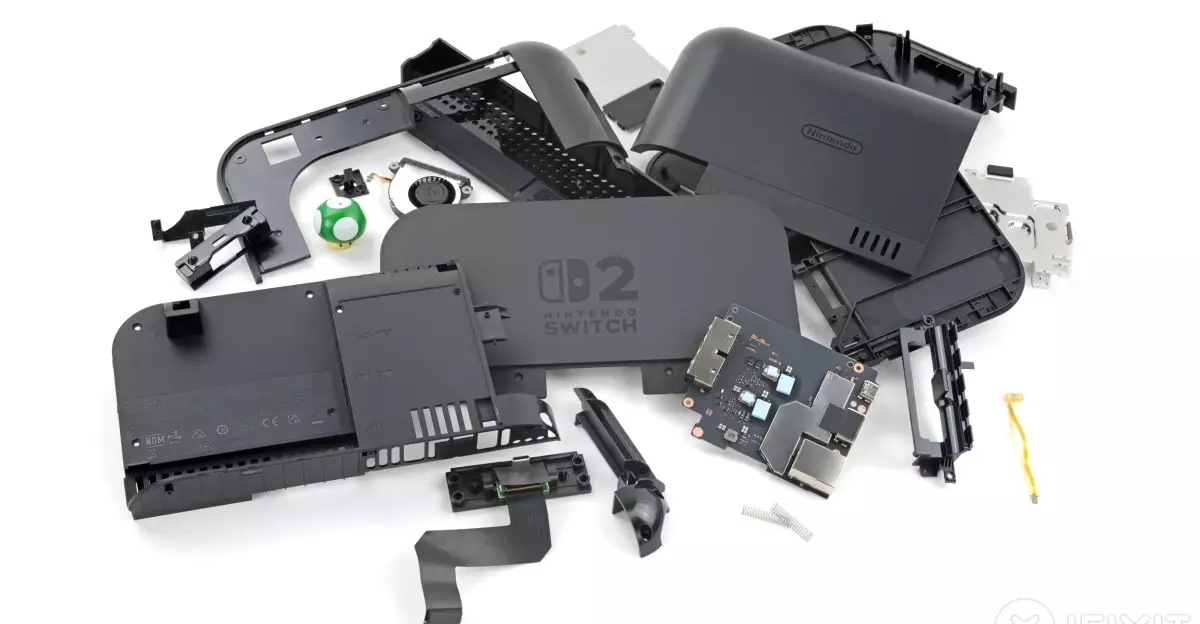In a world of rapid innovation and technological obsolescence, the importance of repairability in consumer electronics cannot be understated. As gadgets evolve, so too do the challenges that accompany their maintenance. The recent teardown of Nintendo’s latest console, the Switch 2, conducted by iFixit, reveals a stark reality: rather than improving the repairability of its systems, Nintendo seems to have taken a step backward. With a disheartening repairability score of just 3 out of 10, the Switch 2 underscores a troubling trend where versatility and accessibility are sacrificed at the altar of design aesthetics and miniaturization.
The Intricacies of Modern Design
One prevalent issue highlighted in iFixit’s teardown is Nintendo’s continued use of difficult-to-remove components, which have become harder to access than ever. The presence of tri-point screws and an abundance of hidden components adds layers of complexity that discourage even the most dedicated DIY repair aficionados. It’s evident that Nintendo has invested more effort into creating a visually appealing, sleek device rather than ensuring its longevity through easy repairs. This design philosophy disregards the needs of consumers who value the ability to mend their gadgets and maintain them over time. By incorporating powerful adhesives and soldered components, Nintendo is sending a clear message that they prioritize the integrity of the assembly over the sustainability of the user’s experience.
The Battery Blues
One area where the Switch 2 stands out for all the wrong reasons is its battery design. iFixit has reported that removing the battery is akin to an “absolute mission,” echoing frustrations reminiscent of the original Switch. The use of aggressive adhesives creates a scenario in which replacement becomes a messy, time-consuming ordeal. Such design choices are concerning, not only because they inconvenience the user but also due to the potential risks associated with attempting to pry apart tightly secured components. With an aging battery life through standard usage, consumers are likely to face dilemmas regarding sustainability and environmental responsibility. The prospect of disposing of a device that cannot be repaired easily further entrenches the cycle of electronic waste.
Complications of Component Compatibility
Another noteworthy finding is the change in modular components. For example, the former game card reader, which could easily be replaced in earlier models, is now soldered directly to the main board of the Switch 2. This shift compromises the modularity that many users appreciated in previous iterations. Alongside this, half-hearted attempts at providing replaceable parts, like the joy-cons, highlight a fundamental contradiction in Nintendo’s approach. While the newer Joy-Cons still face joystick drift issues—problems rooted in the resistive materials used—repairing or substituting these troublesome components has become a Herculean task. By failing to offer proper documentation or accessible repair parts, Nintendo is not just hindering immediate repairs; it is actively contributing to a much larger narrative of disposability in consumer electronics.
Thermal Management Fiasco
One curious aspect worth noting is the application’s use of various thermal pastes throughout the device. The original Switch faced overheating problems due to the solidification of thermal paste over time, leading to performance degradation. Unfortunately, the Switch 2 seems to perpetuate this flaw. With different types of thermal paste applied, users may find themselves in a situation where temperature management becomes another hurdle in maintaining their devices. It raises questions about quality assurance in production as well. Why has Nintendo opted for a varied approach instead of choosing a single effective solution, especially when the consequence may be reduced performance and increased wear over time?
The Road Ahead: A Call for Change
It is essential for companies, particularly titans like Nintendo, to consider the long-term implications of their design choices. Consumers today are becoming increasingly aware of the environmental impact of their purchases. Brands that prioritize repairability not only gain a loyal following of eco-conscious customers but also foster a culture of sustainability that resonates strongly in modern society. The Switch 2 serves as a poignant reminder that while innovation is vital, consumer choice and environmental responsibility should not be overshadowed by aesthetics or profit margins. Nintendo can and must do better, not just for their reputation, but for the next generation of technology users who deserve better solutions.

